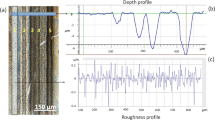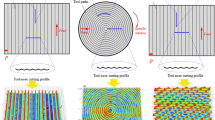Abstract
During the last few decades, much research work has been done to develop accurate tool force models for studying the characteristics of the cutting process in ultraprecision machining based on the concept of shear angles in the chip formation, the fluctuation of which leads to fluctuation of the deformed chip thickness and hence the cutting forces. A microplasticity model is developed in this chapter to analyse the variation of the shear angle and hence the cutting force in ultraprecision diamond turning. The model took into account the effect of material anisotropy due to the changing crystallographic orientation of the workpiece being cut and a spectrum analysis technique is deployed to reveal the features of the cutting force patterns. A series of cutting experiments was conducted on a single crystal with different crystallographic cutting plane normals. The complexity of the shear angle formation is further revealed by a microstructural analysis of the chip cross-sections showing plasticity by means of scanning electron micrographs.
Access this chapter
Tax calculation will be finalised at checkout
Purchases are for personal use only
Similar content being viewed by others
References
Bishop, J. F. W., & Hill, R. (1951). A theory of plastic distortion of a polycrystalline aggregate under combined stresses. Philosophic Magazine, 42, 1298.
Lee, W. B. (1990). Prediction of microcutting force variation in ultraprecision machining. Precision Engineering, 12(1), 25.
Lee, W. B., & Chan, K. C. (1990). Symmetry requirement in shear band formation. Scripta Metallurgica and Materialia, 25, 997.
Lee, W. B., & Cheung, C. F. (2001). A dynamic surface topography model for the prediction of nano-surface generation in ultra-precision machining. International Journal of Mechanical Sciences, 43, 961–991.
Lee, W. B., & Zhou, M. (1993). A theoretical analysis of the effect of crystallographic orientation on chip formation in micro-machining. International Journal of Machine Tools and Manufacture, 33(3), 439.
Reid, C. N. (1973). Deformation geometry for material scientists. Oxford: Pergamon Press.
Shaw, M. C. (1984). Shear strain in cutting. In J. R. Crookall & M. C. Shaw (Eds.), Metal cutting principles (p. 168). Oxford: Clarendon Press.
Yuan, Z. J., Zhou, M., & Dong, S. (1996). Effect of diamond tool sharpness on minimum cut-ting thickness and cutting surface integrity in ultraprecision machining. Journal of Materials Processing Technology, 62, 327.
Zhou, M., & Lee, W.B. (1993). International Journal of Machine Tools Manufacturing, 33(3), 439.
Author information
Authors and Affiliations
Corresponding author
Rights and permissions
Copyright information
© 2018 Springer-Verlag GmbH Germany
About this chapter
Cite this chapter
To, S.S., Wang, V.H., Lee, W.B. (2018). Microplasticity Analysis for Materials Characterisation. In: Materials Characterisation and Mechanism of Micro-Cutting in Ultra-Precision Diamond Turning. Springer, Berlin, Heidelberg. https://doi.org/10.1007/978-3-662-54823-3_7
Download citation
DOI: https://doi.org/10.1007/978-3-662-54823-3_7
Published:
Publisher Name: Springer, Berlin, Heidelberg
Print ISBN: 978-3-662-54821-9
Online ISBN: 978-3-662-54823-3
eBook Packages: EngineeringEngineering (R0)




